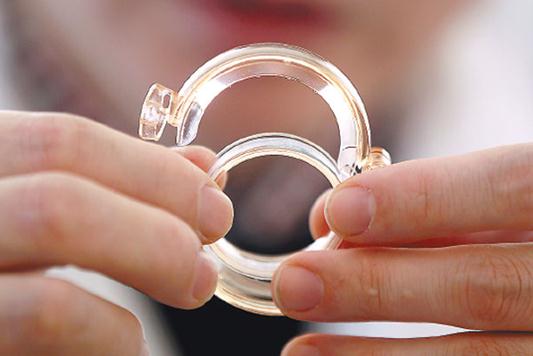

Shang Ring consists of two concentric plastic rings. The use of the ring for circumcision leaves no scars and the patient feels very little pain during the procedure. Zhang Wei / China Daily
A Chinese invention may promote the procedure at home, and help in the battle against HIV/AIDS overseas.
On April 4, 2012, Bill Gates visited Stanford University for a question and answer session with students. During a brief presentation on the innovations that are helping African countries, the billionaire Microsoft boss showed off an ingenious invention from China. It was small, pink, and consisted of two concentric plastic rings. "It's a fantastic development. It's just plastic, so it's very cheap," he said. "It reduces the pain involved. It reduces the cost involved. It's very straightforward."
Fast-forward almost three years. It's January, and an electrician is installing bulbs to meet lighting standards on the production line at Wuhu Snnda Medical Treatment Appliance Technology Co in East China's Anhui province. If the invention Gates displayed at Stanford passes the World Health Organization's prequalification process in the next few months, Wuhu Snnda will begin full production.
The device, called the Shang Ring after its inventor, Shang Jianzhong, is the latest development in circumcision - the surgical removal of the foreskin, the retractable fold of tissue that covers the head of the penis.
Shang always laughs when he recalls the circumcision he had 13 years ago to treat an ailment, but the 60-year-old's experience was far from humorous. The surgery, performed at a clinic in Anhui, took 30 minutes as the surgeon snipped the foreskin and then stitched the wound in the classic procedure that's performed every day in some part of the world. After the operation, Shang was put on a drip and given oral antibiotics to prevent infection. He was also banned from taking a shower for seven days.
A month later, however, the results were unsatisfactory. The surgery had left several prominent scars, and "even more embarrassing was that the surgeon had cut the foreskin a little more than necessary, and my erection became shorter than before", Shang said. Experts say these "defects" may be unavoidable with conventional surgery; the scars are caused by the stitches, and the length of the foreskin always depends on the individual surgeon's technique.
In light of the problems he'd encountered, Shang, who spent eight years as a mold-maker before working as a surveyor at a mapping institute, decided to put his technical skills to good use and design a device to aid circumcision.
The result was the Shang Ring, a disposable device consisting of two concentric rings that clamp together and expose the foreskin so it can be removed surgically, but with minimal bleeding. The ring is removed seven days after the surgery when the wound has healed. Because the procedure doesn't require stitches, the patient is allowed to bathe and only requires oral antibiotics. The use of the ring also cuts the procedure time to about three to five minutes from about 30 before.
"People may be surprised to learn that such an innovative idea was nurtured in China, where the circumcision rate is extremely low," Shang said. "My reply is this: No matter how many circumcisions have been done in a country, each one is extremely important to the man concerned, to his health and self-confidence. A safer, semi-surgical device will encourage more people to learn about circumcision, and maybe choose to have the procedure."
60 percent of HIV cases affect foreigners
2015-02-02HIV-infected woman claims discrimination in child‘s death
2015-01-28Health official defends hospital in girl‘s HIV infection
2015-01-21China reports over 100,000 new HIV/AIDS infections in 2014
2015-01-16China to reduce HIV infections contracted via blood transfusions
2015-01-13Copyright ©1999-2018
Chinanews.com. All rights reserved.
Reproduction in whole or in part without permission is prohibited.